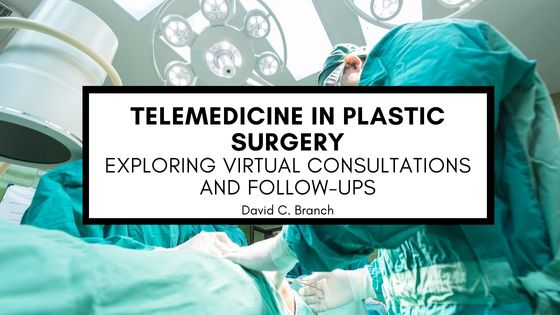The integration of technology into healthcare has paved the way for transformative changes, particularly in the field of plastic surgery. Telemedicine, the provision of healthcare services through digital platforms, has become increasingly prevalent, offering new possibilities for virtual consultations and follow-ups in plastic surgery. In this blog post, we explore the evolving landscape of telemedicine in plastic surgery, highlighting the benefits, challenges, and the potential it holds for both practitioners and patients.
The Rise of Telemedicine in Plastic Surgery:
- Virtual Consultations: Telemedicine has redefined the initial stages of patient-doctor interactions in plastic surgery. Virtual consultations enable patients to connect with plastic surgeons from the comfort of their homes, eliminating geographical barriers. This approach allows for an initial assessment of patients’ concerns, preferences, and expectations.
- Convenience for Patients: One of the primary advantages of telemedicine in plastic surgery is the convenience it offers to patients. They can schedule consultations without the need for travel, saving time and effort. This accessibility is particularly beneficial for individuals who reside in remote areas or have limited mobility.
- Efficiency and Time Savings: Virtual consultations enhance the efficiency of the pre-surgical process. Patients can share photographs or videos of the areas they want to address, enabling surgeons to make informed recommendations. This streamlines the consultation process, reducing the need for multiple in-person appointments.
Benefits of Virtual Follow-ups:
- Postoperative Monitoring: Telemedicine plays a vital role in postoperative care by facilitating virtual follow-ups. Patients can connect with their plastic surgeons for remote assessments, enabling healthcare professionals to monitor the healing process and address any concerns. This real-time monitoring enhances the overall quality of postoperative care.
- Reduced In-Person Visits: Virtual follow-ups can reduce the frequency of in-person visits for routine check-ups, minimizing disruptions to patients’ daily lives. This is especially advantageous for individuals with busy schedules or those who may face challenges traveling to the clinic regularly.
- Cost Savings: Patients can experience cost savings associated with travel expenses, parking fees, and potential time off from work. Virtual follow-ups contribute to a more cost-effective postoperative care model without compromising the quality of patient monitoring.
Challenges and Considerations:
- Technological Barriers: While telemedicine offers numerous benefits, technological barriers can pose challenges. Patients may encounter difficulties with internet connectivity, video quality, or using the necessary devices for virtual consultations. Addressing these challenges is essential for ensuring seamless telemedicine experiences.
- Ensuring Privacy and Security: Plastic surgery consultations involve sensitive discussions and personal information. Ensuring the privacy and security of telemedicine platforms is crucial. Implementing robust encryption and compliance with healthcare data protection regulations are imperative to maintain patient confidentiality.
- Limitations in Physical Examination: Virtual consultations have limitations when it comes to physical examinations. While surgeons can assess certain aspects through video or photographs, a complete physical examination may be challenging. Balancing the benefits of virtual consultations with the need for in-person examinations is a consideration for practitioners.
The Role of Technology in Virtual Plastic Surgery Consultations:
- High-Resolution Imaging: Advanced imaging technologies allow patients to share high-resolution photographs or videos of the areas they wish to address. This visual information aids plastic surgeons in making accurate assessments and formulating personalized treatment plans.
- Augmented Reality (AR) and Virtual Reality (VR): The integration of AR and VR technologies enhances the virtual consultation experience. Surgeons can use these technologies to simulate potential outcomes, allowing patients to visualize the anticipated results. This interactive approach fosters better communication between surgeons and patients.
- Secure Communication Platforms: Utilizing secure and compliant communication platforms ensures the confidentiality of patient information during virtual consultations. Healthcare professionals can leverage encrypted video conferencing tools to conduct private and secure interactions with their patients.
Regulatory Considerations:
- Compliance with Telemedicine Regulations: As telemedicine in plastic surgery continues to evolve, practitioners must stay abreast of telemedicine regulations and guidelines. Adhering to these standards ensures ethical and legal practice, safeguarding both patients and healthcare providers.
- Informed Consent Protocols: Establishing robust informed consent protocols for virtual consultations and follow-ups is crucial. Clearly communicating the limitations of virtual assessments and obtaining patient consent for remote care are essential components of ethical telemedicine practices.
The Future of Telemedicine in Plastic Surgery:
- Hybrid Care Models: The future of plastic surgery may see the emergence of hybrid care models that blend virtual consultations with in-person visits. This approach optimizes the benefits of telemedicine while ensuring that patients receive comprehensive care that includes necessary physical examinations.
- Continued Technological Advancements: Ongoing technological advancements will further enhance the capabilities of telemedicine in plastic surgery. Innovations in imaging technologies, AI-assisted diagnostics, and virtual reality simulations are likely to play a significant role in shaping the future of remote patient care.
- Global Accessibility: Telemedicine has the potential to increase global accessibility to plastic surgery expertise. Patients around the world can connect with renowned plastic surgeons without the constraints of geographical boundaries, fostering a more interconnected global healthcare community.
Telemedicine has emerged as a transformative force in the field of plastic surgery, redefining how patients access consultations and follow-up care. The convenience, efficiency, and cost-effectiveness of virtual interactions contribute to a more patient-centric approach. While challenges exist, ongoing technological advancements and regulatory frameworks will likely address these issues, paving the way for a future where telemedicine in plastic surgery becomes an integral part of comprehensive patient care. As technology continues to bridge gaps and redefine healthcare delivery, the fusion of aesthetics and digital innovation holds promising potential for the future of plastic surgery.

